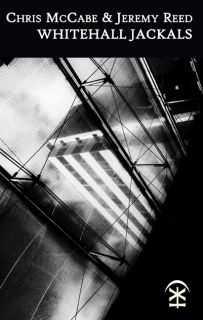The poems and short prose passages in this collection carry a charge, they’re alive with verbal electricity and a sense of the purpose defined by their authors in “Coda Prefix: Accelerated Urban Highs”, an introduction which both explains how the two poets came together to produce this first part of a projected two-volume “London Collaboration”, “poetry resulting directly from London as our creative experiental basis” and, at the same time, takes the form of a manifesto: “… if a poem doesn’t radically alter your sensory experience of the world and recreate it, then it’s of no interest, and if it doesn’t risk shooting holes in the corruptly-maintained system, it lacks dialect with subverting politics …”. The message is clear: “Chris McCabe and I have tried in “Whitehall Jackals” to break laws rather than observe them – isn’t that the best reason to write? – to disrupt convention and become in the process edgewalkers”.
Virtually all of the collection’s thirty-nine pieces have as their title either the name of a district, place or specific feature of London, each intended to bring to life not simply geographical locations, because not all potential readers will know London, but, more importantly, the continuity of links between the city’s ever-morphing present, its long past and the myriad individual ways in which that past may be viewed, a preoccupation which countless millions of the world’s city-dwellers must surely share. Hence, the term “edgewalkers” comes to define not only the cultural and political positions the authors perceive themselves as occupying, their anger and contempt for those whose intention, in their opinion, is to subvert or destroy what they hold dear, but also their passionate interest in and long-term dedication to a particular way of life.
In “Red Snapper, Cecil Court”, for example, Reed writes with relish about Red Snapper Books, the “low-lit, book-stacked basement … a cutting-edge counterculture bookshop”, “… run as banditry / for poets, outlaws, dealers, criminals, / tumble-in types like skewed Pete Doherty” until “The bailiffs squeezed us … and (we) lost it all”. In a lighter, more ironic vein, although with no less edge, McCabe’s “Elephant & Castle” develops similar views about the importance of learning, internalizing, the life of the city and suggests “something light to read on the commuter’s underpass: / A Beginner’s Guide to Property & Culture”. Tongue in cheek, but the point is well made: it is vital to care. In “City of London”, by contrast, he makes darker reference to and quotes from “The Burial of the Dead”, Part 1 of “The Waste Land”, in which T. S. Eliot describes London as an “Unreal City” and says of it very bluntly that, “Under the brown fog of a winter dawn, / A crowd flowed over London Bridge, so many, / I had not thought death had undone so many.” An interesting connection given the rôle played in this collection by decay and loss, death and the passing of time.
As perceived agents of the destruction of a way of life, a culture and a value system the authors hold dear, property developers, money-men, the owners of international hotel chains, politicians such as Margaret Thatcher and, very particularly, Tony Blair, “the psychopathic jackal … his handgun grin / cold as forensics, czar to every war’s / genocide, the killer autocrat / smeared in depleted uranium, Gulf blood …”, come in for harsh treatment. In Blair’s case more than once, firstly in “Whitehall Endgame (depleted uranium mix)” quoted above and, later, very vitriolically indeed, in “The Right Hon Jackal Blair”: “The guilt lodged like a bullet in his brain / he can’t extract, a toxic leak / like slow-dose polonium. / His look’s impassive as an army truck / an explosive self-propelled howitzer.”
There are, however, limitations to this perception of change as threat. Reed identifies one such, nostalgia, in “Ham Yard W1”, when he concedes that, “You can’t recreate history; it’s a series of inaccessible space-times hijacked by imagination, but essentially wiped …”, although there remains a sense, nonetheless, in which he and McCabe seem to want to have their cultural cake and eat it too. Ham Yard, we’re told, began as “a lowlife pub called the Ham in existence there in 1739 … used by robbers and stick up highwaymen”. Thereafter and jumping a couple of centuries, it’s been made over many times, as a venue for skiffle, jazz and R & B, a centre for drug-taking ( “in pilled-up 1964, the site was also known as Pill Yard”) and a “derelict piss-drenched 0.75 acre Soho yard”, until in 2010 it was sold “for around £30M to build a luxury 100 room hotel, plus 50,000 square feet of housing on an indigenously proto-hipster landmark”.
That Reed and McCabe don’t like what’s happening, that they mourn the loss of what they define as the “real”, is obvious: in future the life of one particular corner of Soho and, by implication, other areas such as Docklands, will have nothing to do with London culture and people, but a lot to do with money; a venue that hosted great Sixties bands, “The Jagger phenomenon: 135lbs of skinny dance compression on a compacted 10ft stage”, will become a watering-hole for the moneyed and the monetisers, purpose-built to exclude London’s hoi polloi. But while it’s important to keep alive the memory of the city’s soul, Londoners such as Shakespeare, Blake, Wilde, Chatterton and Marlowe, “The tattooed boozed-up brawler on Hog Lane”, the past, as “Seven Dials” makes clear, was a country where they did things so differently that nobody in their right mind would want to go back: “If we died on the street, left to decay, / would rot be faster than a pizza box / or open jar of mayonnaise …? / We’re a mismatched global academy”, Reed says, “at this dysfunctional take-no-prisoners site.” Yes indeed, but if we all dance “Death Tango” in the end and “the moment turns on language that the street deletes”, “watcha gonna do / do baby blue”?
Order your copy of Whitehall Jackals by Chris McCabe & Jeremy Reed published by Nine Arches Press, here
©2013: Ken Head

